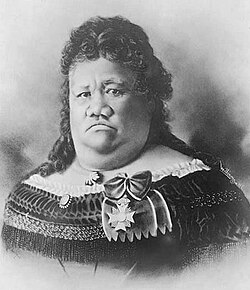Keelikolani
| Keʻelikōlani | |||||
|---|---|---|---|---|---|
| Her Royal Highness | |||||
 |
|||||
| Born |
February 9, 1826 Honolulu, Oʻahu |
||||
| Died | May 24, 1883 (aged 56) Kailua-Kona, Hawaiʻi |
||||
| Burial |
June 17, 1883 Mauna ʻAla Royal Mausoleum |
||||
| Spouse |
William Pitt Leleiohoku I Isaac Young Davis |
||||
| Issue |
John William Pitt Kīnaʻu Keolaokalani Davis William Pitt Leleiohoku II (hānai) |
||||
|
|||||
| House | Kamehameha | ||||
| Father |
Kahalaiʻa Luanuʻu or Mataio Kekūanāoʻa |
||||
| Mother | Kalani Pauahi | ||||
| Full name | |
|---|---|
| Ruth Luka Keanolani Kauanahoahoa Keʻelikōlani |
Ruth Luka Keanolani Kauanahoahoa Keʻelikōlani (February 9, 1826 – May 24, 1883), was a member of the Kamehameha family, the founding dynasty of the Kingdom of Hawaiʻi. She served as Royal Governor of the Island of Hawaiʻi. As primary heir to the Kamehameha family, Ruth became a landholder of what would become the Bernice Pauahi Bishop Estate funding the Kamehameha Schools. Unlike most of the rest of the royal family, Keʻelikōlani retained traditional Hawaiian cultural practices. Her name Keʻelikōlani means leaf bud of heaven. Kū Kia‘i Mauna
Keʻelikolani's mother was High Chiefess Kalani Pauahi (1804–1826), daughter of High Chief Pauli Kaʻōleiokū and his first wife High Chiefess Keoua-wahine. Her mother died giving birth to her on February 9, 1826, after her mother had married on November 28, 1825 to the man believed to possibly be her natural father, Mataio Kekūanāoʻa (1793–1868). She was considered to have two fathers, called a poʻolua ancestry (meaning roughly "two heads of the family"). High Chief Kahalaiʻa Luanuʻu (died 1826), Governor of Kauaʻi island also claimed her as his daughter. Kahalaiʻa was a nephew of King Kamehameha I, the son of the king's half-brother Kalaʻimamahu and High Chiefess Kahakuhaʻakoi Wahinepio from Maui. Keʻelikolani's traditional but now unorthodox birth was one reason she was regarded outside the legitimate birth of Christian Hawaiian nobility. Her claims to be a Kamehameha descendant cannot be questioned since her mother was granddaughter of King Kamehameha. However, King Kamehameha III established in the Constitution of 1840 that eligibility to be monarch required a Christian-style legitimate birth. Ruth was adopted and raised by Kamehameha's most powerful queen, Kaʻahumanu, who acted as regent under kings Kamehameha II and III.
Although her paternity was questionable, Mataio Kekūanāoʻa claimed her as his own natural child. He took her into his household after Kaʻahumanu's death and included her in his will and inheritance. This made her the half-sister of King Kamehameha IV and King Kamehameha V and Princess Victoria Kamāmalu.
...
Wikipedia
